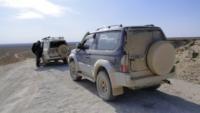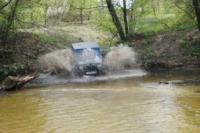Вы здесь
Tours from Uzbekistan to Tajikistan.





Jeep tours from Uzbekistan to Tajikistan.
“It is good to have an end to journey toward; but it is the journey that matters, in the end»
Ursula K. Le Guin. «The Left Hand of Darknes».
More than 2,000 years ago, Alexander the Great led his armies in an epic campaign of conquest across Central Asia. Alexander subdued the bactrians and Sogdians, the ancestors of modern Tajik people; took a Sogdian wife for himself; and founded the city of'Alexandria the Furthest'.
Re-live the adventure and romance of Alexander's journeys on this exciting tour. In 329 ВС, having defeated of King Darius of Persia, Alexander the Great pressed on to begin his military campaign in Central Asia. After crossing the Hindu Kush and conquering Bactria, Alexander and his armies crossed the river Oxus (Amu Darya), which today forms the border between Tajikistan and Afghanistan. After a fierce and lengthy battle, Alexander captured the capital of Sogdiana, Marakanda (modern Samarkand).
Alexander continued north to the river Jaxartes (Syr Darya), where he founded a new city, Alexandria Eschate or "Alexandria the Furthest" (modern Khujand), as a garrison to protect against the nomadic tribes to the north of the river. The Sogdians were not content to submit to Macedonian rule, and a period of opposition and bloody uprisings followed. Over the next two years, Alexander fought against the Sogdians, finally defeating the rebel leader Spitamenes.
One of the last strongholds to fall was the mountain fortress known as the Sogdian Rock (in modern Tajikistan). There Alexander discovered and fell in love with Roxanne (Tajik: Rukshona), who had the reputation of being the most beautiful woman in Central Asia. Alexander married her and this helped to seal the peace with the Sogdians. Many of Alexander's commanders also intermarried with local people. The blue eyes and light hair of this Greek stock can still be seen in some mountain regions in Tajikistan.
About jeep tour in Tajikistan.
This jeep tour follows the path of Alexander through the cities and mountains of Uzbekistan and Tajikistan. The tour begins in Samarkand - the palace at Afrosiab was Alexander's base during the three years that he spent in Central Asia and Khudjand founded as "Alexandria the Furthest".
Heading east up the Zerafshan Valley, we trace the heritage of the Sogdian civilisation which resisted Alexander until he took Roxanne, the daughter of a Sogdian noble, as his bride. Appropriately, the tour finishes in Dushanbe.
Optional: this tour is available with an expert guide - a historian who will be able to explain the details of Alexander's exploits in situ. Please ask for details.The short description of a route from Uzbekistan to Tajikistan:
Tashkent – Samarkand – Khudjand - town of Istaravshan - settlement Shakhristan - Pass Shakhristan of 3378 meters above sea level - town of Pendjiken - settlement Sarazm - settlement Mazori Sharif (mausoleum Mukhammad Bashoro) - settlement Aini - lake Iskanderkul - Dushanbe.
Distance of route: 1454 km.
Season: from June 1th till September, 30th.
Best time for excursion: July - August.
Duration of tour: 8 days, 7 nights.
The detailed program tour from Tashkent to Dushanbe:
Vacation packages in Tajikistan.
Day 1. Tashkent.
Arrival in Tashkent. Meet group off the plane at Tashkent International Airport and transfer to hotel. Freshen up, then visit the old city: Chorsu Square (XI century) was the centre of ancient Tashkent. It was a crossroads and place of trade. The Chorsu bazaar still stands on one side of the square - this is the oldest city market, built according to the ancient style. Also on the square is the Kukeldash Madrasah (XVI century) and Juma (Friday) Mosque (XV century).
Khazret Imam Square (XVI century) is framed by Kaffal Shashi Mausoleum, Barak Khan Madrasah, and two mosques. The Tillya Sheikh Mosque (1902) houses a rich Islamic library with ancient manuscripts, including the immense Osman Koran, one of the world's oldest copies (1200 years old).
Note. This schedule assumes a morning arrival at Tashkent. The programm may need adjustment depending on actual flight arrival times.
Day 2. Tashkent – Samarkand (350 km).
Breakfast. Transfer to Samarkand. Arrives in Samarkand, transfer to hotel, accommodation. Start excursions in Samarkand. From about the VI century ВС, Samarkand (Maracanda) was one of the flourishing satrapies of the eastern Achaemenid Empire. Part of the reason for Alexander's war was to assert his claim over me lost provinces of the Achaemenids. At the time of his arrival, Maracanda was the capital of Sogdiana, occupying the hill of Afrosiab mat rises to the north of the modern city.
The city had a citadel and strong fortifications, and occupied some 13 Km. Spitamenes beseiged the city in 329 ВС at the beginning of his rebellion against the Macedonians. After lunch, visit the site of ancient Maracanda (Afrosiab). This is a hilly area of 212 hectares surrounded by a moat. It is an active archaeological site and several layers have been partially excavated, including Sogdian and Greek-Bactrian remains. Excavation has also uncovered the palace of a ruler, containing large halls with smaller rooms and corridors between them.
The walls are made of beaten-clay bricks, and contain remnants of decoratively carved wooden beams and caryatid pillars. This is probably the place where Alexander hosted his famous drinking parties; on one of those occasions he lost control of himself and killed his commander Qeitus. The museum on the site has a model of the ancient city and fortress walls, and artefacts which show the influence of classical Greek culture: pottery, weaponry, coinage and altars. After dinner transfer to hotel, overnight.
Day 3. Samarkand.
Breakfast. Visit the world famous Registan Square (XIII century), which was the centre of trade and cultural life in medieval Samarkand. It is surrounded by three of the most impressive madrassas in Central Asia (XV – XVIII centuries) and is also close to the Shakh-i-Zinda (Tomb of the Living King), which has been a site of pilgrimage for 1,000 years.
In the afternoon, visit the Museum of the Cultural History of Uzbekistan, which includes houseware and ossuaries from Afrosiab, painted copies of its fragmented murals and replicas of finds from ancient Bactria, including the Kushan Ayrtam frieze. After dinner transfer by train “Evening Shark” to Tashkent, at 19.30, arrives in Tashkent at 22.50, meeting on train station, transfer to hotel, accommodation, overnight.
Day 4. Tashkent - Check Point «Oibek» (Uzbekistan) - Check Point «Fotekhobod» (Tajikistan) - town of Khujand (164 km).
Breakfast. Transfer: Tashkent - a check point «Oibek» (97 km). Meeting on tourists on a check point «Fotekhobod».
Transfer: a check point «Fotekhobod» - the town of Khujand (67 km). Arrival in Khujand. Khudjant – town in the north of Tajikistan, administrative centre Sogd of province. One of the most ancient towns of the Central Asia. The town of Tajikistan second on the size, the important transport unit, political, economic, cultural and a centre of science of the country. From January, 10th, till February, 26th, 1991 the city carried a name Leninabad (the town has been named in honour of Century of V.I. Lenin).
Continue to the city of Khujand, which was founded as Alexandria Eschate - "Alexandria the Furthest". Ancient Greek and Roman authors considered Khujand the frontier of Asia. There is archaelogical evidence of buildings which predate Alexander's arrival, but Alexander's biographer Arian tells us that in 329 ВС, Alexander ordered that the city be reinforced with strong walls. Alexander built his northernmost altars dedicated to Dionysus on the mountain slopes above the city, perhaps somewhere near the spot where the huge paternal figure of Lenin now stands.
Excursion on town, visiting of a historical museum. The museum is opened on November, 29th, 1986 in days of celebrating of the 2500 anniversary of Khudjant. He is located in premises fortress walls of east fortification Khudjant of a fortress VIII - X в.в., which was a part of defensive fortifications of town.
Visiting Khudjant of a fortress. During all history Khudjant heart of city was its fortress. For 2500 Khudjant the fortress extended together with city, collapsed conquerors, built up anew, always remained a symbol of stability of Tadjik people.
Visiting of mosque Masdzhidi Djami. The mosque has been constructed in 1512 - 1513. Iwan of 30 columns, adjoins east wall of a winter hall, here too there are 20 columns and enters into a courtyard of a mosque. The base of a mosque on which walls of a building stand, are laid out from burnt a brick.
Visiting of a palace «Arbob» S.Urunhodzhaev nam. It is one of great architectural places of interest in the town of Khudjand constructed under the initiative e of twice Hero of Socialist Work (1948 1957) Saidkhodji Urunkhodjaev, in 1959.
Visiting of the mausoleum of Sheikh Muslihiddina. It is the large memorial ensemble which is being a historical part of town, it is constructed on tomb Muslikhiddin Khudjandi - the governor of the town of Hudzhanta, the poet lived in XII century. Legends say, that sheikh Muslikhiddin was sacred wondermonger. Visiting popular and well-known market Panchashbe, located in downtown. The market is the greatest closed market in the Central Asia, charm buyers the diversity, the various smells, a rich choice of fruit and vegetables.
«Panchashbe” - the fourth day of week (Thursday, in translation from the Tadjik language), during old times it was day of the big trade. Lunch. After a lunch a trip on Kairakum a water basin - the Tadjik sea. Walk in vicinities, rest, bathing. Returning in Khudjand. Dinner and overnight in hotel.
Day 5. Town of Khudjand - town of Pendjikent (263 km).
Breakfast. Transfer: Khudjand - the town of Istaravshan (78 km). Istarafshan is an ancient city which has been identified with Cyropolis, which was sacked by Alexander during the rebellion of Spitamenes. Alexander was wounded on his head by a catapult stone during the siege and suffered temporary blindness.Altho ugh Istarafshan is very close to Khujand, it is very different in character.
Whereas Khujand was conquered and reconquered throughout its history, Istarafshan was always rebellious and fought hard for its independence. This history has shaped the character of the people who live in the city and even in recent years mey have shown their independent nature by refusing to accept the mayor appointed by the president, replacing him with a local man.
The town of Istaravshan is in Sogd province of Tajikistan, is an administrative centre of area Istaravshan. It is located in the north of Tajikistan, in foothills of the Turkestan ridge. Earlier the town was called - Ur-Tyube. On November, 10th, 2000 the town has been renamed in - Istaravshan. The population of city 59 900 person (according to 2015). Istaravshan - town-museum, the ancient center of trade and the crafts, one of the most ancient towns of the Central Asia. In 2002 Istaravshan it was executed 2500. The town is based in VI century B.C. Akhmenid by tsar Kirom, has strengthened settlement three of some walls and a citadel. Arrival in Istaravshan.
Visiting of a mosque-madrasah the Kook-Gumbez (XVI century). The Mosque-madrasah the Kook-Gumbez is located in the western part of town and is called because of blue tiles of a dome. The Kook-Gumbez in translation into Russian means «The Blue dome»). Mosque-madrasah it is constructed under initiative Abdulatif of the Sultan - the son of the well-known scientist-astronomer and the philosopher - Ulugbek, grandson Amir Timur.
Visiting of mausoleum Khazrati-Shokh (XVIII century). In the mausoleum it is buried sacred Khazrati-Shokh - native brother Kusam Ibn Abbas, the cousin of prophet Muhammada, bury in XI century in the Samarkand architectural ensemble Shakhi-Zinda. The mausoleum one of the most ancient places of interest of Tajikistan, is included in a history-architectural complex «Khazrati-Shokh» which is in an old part of the town of Istaravshan. The complex consists of three cult constructions: mausoleum Khazrati-Shokh, mausoleum Khudoer Valami and mosques Khazrati-Shokh (known as Namazgokh), are dated XIX century. All three structures are located by a semicircle. Each of them is constructed at various times and has the history of creation and purpose.
Visiting of mausoleum Chor-Gumbaz (the beginning XIX end of XX centuries). Mausoleum Chor-Gumbaz is located in northwest part Istaravshan at a tomb of local religious figure Eshoni Mavlono. The mausoleum represents obit a mosque with a wooden dome and a column. In 2001 - 2002 the mausoleum has been restored in honour of the 2500 anniversary of the town of Istaravshan.
Visiting of mosque Khavzi Sangin. The mosque has been constructed in 1904 of the last century. This construction has received the name from khauz (reservoir) which coast are strengthened by a stone. According to a legend, the reservoir has been constructed under the order of Sultan Parvonachi. Stones carried on camels. After end of all works the Sultan has presented all camels to slaves and has released them on freedom. Near a mosque there is a small mausoleum. Under some data, in 1895 the mausoleum was called Shofozil Ibn Abbas, and the building has been constructed in 1795. Under other data here it is buried Fuzail Ibn Abbas.
Lunch in local cafe. Transfer: town of Istaravshan - Istaravshan a water reservoir (12 km). A stop at a water basin, photographing. Our way goes through the Turkestan ridge.
Further transfer: Istaravshan water reservoir - pass Shakhristan (61 km). A stop on pass, short walk in vicinities, photographing. In the West from pass the Dzhizak province of Republic Uzbekistan is well looked through.
Further transfer: pass Shakhristan - Pendjikent (112 km). After settlement Aini our way to Pendjikent on Zerafshan to a valley along the river Zeravshan. Arrival in Pendjikent, transfer to hotel, accommodation, a dinner and overnight.
Day 6. Pendjikent - lake Iskanderkul (207 km).
Breakfast. The town Pendjikent located in the western part of Tajikistan on left I protect the rivers Zaravshan to the east of Samarkand. The town towers at height of 900 meters above sea level. Pendjikent it is well-known for monuments of architecture, a zone of sea tour of the river Zaravshan. The status of the town of Pendjikent has received in 1953. The Population for 2003 has 34 000 person. Pendjikent is one of the most ancient cities of the Central Asia which age makes 5500 years.
The name of city on Russian is translated as «Five settlements». In V - VIII centuries н.э. Pendjikent represented one of the major cultural and craft centers of Sogdiana. The beginning of excursion on Pendjikent and to vicinities. Visiting of a museum of name Rudaki, the founder of the Tadjik classical literature.
Visiting of ancient site of ancient settlement Pendjikent.
The site of ancient settlement ancient Pendjikent is archeologic monument V - VII centuries and borrows territory in 13,5 hectares. The site of ancient settlement consists of strengthenings, shakhistan with a defensive wall, suburban manors and a necropolis. The town has been constructed in V a century and has existed till VII century. Excavation on a site of ancient settlement are conducted since 1947. Walls of many houses were saved up to the second floor. In total 2 palace complexes, 2 temple complexes, 2 market complexes, 8 streets, tens multiroom houses of the nobility and ordinary citizens, city walls V - VIII centuries are dug out.
Transfer: the city of Pendjikent - settlement Sarazm (13 km). Settlement Sarazm IV - II millenia B.C., located close Pendjikent, with well saved temples of fire, public and residential buildings, cult and palace constructions. Here many products from copper, bronze, lead, silver, gold, the weapon, the ornaments concerning to IV - to II millenia up to B.C. have been found. The settlement represents extended with the West on the east a height on left I protect the rivers Zeravshan. The Total area of settlement exceeds 100 hectare. Sarazm was the center of ancient manufacture of ore. Its inhabitants, have found gold and silver in valley Zaravshan, sent it in the countries of the Average and the Near East and the Western India. Returning in Pendjikent (13 km). A lunch in cafe of town.
After a lunch transfer: Pendjikent - settlement Mazori Sharif (33 km). In settlement Mazori Sharif visiting of mausoleum Mukhammad Bashoro. Mausoleum Mukhammad Bashoro is an architectural monument XII - XIV centuries and consists from spacious of some domes with inputs on the main facade. The mausoleum is located in one of fine gorges of northern mountains Zeravshan of a ridge. About person Mukhammad Bashoro it is known very little.
The mausoleum consists of a spacious central dome hall, at the left and to the right of which a number of premises is located. The main facade of the mausoleum leaves to the mountain river, from here to it the road conducts. Originally the mausoleum has been constructed without a portal. In XIV century the portal, with a decorative carved terracotta (it is cut out on crude clay, is burnt and collected on a portal) unique beauty and complexity has been constructed.
Transfer: settlement Mazori Sharif - settlement Aini - lake Iskanderkul (139 km). On a way to settlement Aini visiting Aini a minaret. Arrival on a pearl of mountains Fany - lake Iskanderkul. Transfer on a camp center «Iskanderkul», accommodation. There is an opinion, that the lake Iskanderkul is named in honour of Alexander the Great, the ancient greek commander who has won local mountaineers, has created this lake and has flooded settlements of mountaineers.
The lake, is mentioned, in descriptions of a campaign of Alexander the Great and to these the antiquity of lake proves to be true. The level of this lake gradually decreases, to what coastal stones on slopes of mountains surrounding lake testify. A lunch in eating house in the camp center. After a lunch walk on 38 a meter falls and five springs Panchashma. Returning to a camp center. A dinner and overnight.
Day 7. Lakes Iskanderkul - city Dushanbe (120 km).
Breakfast. After a breakfast transfer to the most beautiful valley of Tajikistan - valley Saratog. Valley Saratog is surrounded mountains Fany, from here opens a kind on the highest peak of mountains Fany - peak Chimtarga of 4955 meters above sea level.
Transfer: kishlak Saratog - lake Iskanderkul - pass Anzob (30 km). On a way a stop on pass Anzob, short walk and photographing in vicinities pass. From road the surprising landscape on mountains of Ghissar mountains opens, the road up to pass Anzob goes along the river Varzob. Transfer: pass Anzob - Dushanbe (90 km). In front of Dushanbe we shall go through picturesque gorge Varzob, here it is a lot of vacation spots, hotels, cafe and restaurants. Arrival in Dushanbe, transfer to hotel, accommodation, rest, free time. Dinner and overnight.
Optional: Groups who would like to include some trekking in the mountains may be interested in a side trek to the village of Kiryonte in Yaghnob Gorge. The people ofKiryonte still speak the same language that Alexander would have heard when he came to Central Asia. They are descended from the Sogdians who fled Penjikent during the Arab invasions, and have preserved the Sogdian language and culture for centuries in this mountain fastness. Their houses resemble swallows' nests. The route to Kiryonte is particularly scenic, passing a panorama of huge mountain peaks with sharp rocks covered with snow and ice. A one - kilometre rock soars above Margib village, called Zaminkaror, or "Holder of the Earth". Allow five extra days for this trek.
Day 8. Dushanbe. Excursion on sights of Dushanbe.
Breakfast. The beginning of excursion on city Dushanbe to capital of Tajikistan. The city Dushanbe, till 1961 was called - the city of Stalinabad. Dushanbe is located in center Ghissar of a valley at height more than 800 meters above sea level. From the north and the east it is surrounded with mountains with snow-white tops of Ghissar mountains. The highest tops rise up to heights of four and more thousand meters above sea level, from the southern party the river Kafirnigan proceeds.
Visiting of a museum of ethnography. The collection of ethnographic places of interest of culture and a life of Tadjik people is stored in a museum of ethnography of Tajikistan. The building of a museum of ethnography has been constructed in 1934.
Visiting of a national museum of antiquities of Tajikistan. Opening ceremony of a new building of the National museum of Tajikistan took place in March, 2013 in Dushanbe. The museum consists of 22 greater and small exposition halls. These are departments of the nature, an antiquity of the Middle Ages new and the newest history, graphic and applied arts.
Visiting of Park of a Victory over hills where it is possible photographing a panorama of city Dushanbe. Lunch in local cafe or restaurant.
Visiting of East market Shokhmansur. Market Shokhmansur - the central market of city, at a market is also the second name - the Green Market. The market noisy, close, interesting and diverse. Here it is possible to get everything, that you will wish from food stuffs up to national clothes and souvenirs. Evening walk on downtown at monument Somoni, in park Rudaki, at national library of Tajikistan, on the area where is a flag of Tajikistan.
Dinner in national tea bar Rokhat. Tea bar Rokhat has won sympathy and love of the clients since 1958. Since second half XX century is the biggest and popular tea bar Dushanbe. The wooden east patterns created by hands of the Tadjik masters, are an original work of art which made national colour, as does tea bar Rokhat by place of interest of city. Returning in hotel, overnight.
Price Quotation.
There are a number of factors which we will use to determine the price:
The exact itinerary and options that you select .
Type of vehicle (Western 4WD with aircon).
Seating arrangement (3 passengers per car or 4 passengers per car).
Accommodation options (best available or most economical).
Timing of trip. The season for this itinerary is from June until October. We can offer a discounted rate at the beginning (June) or end (October) of the season.
Normally we include the following services in our quotation:
All documentation and paper work (visa support, registration with OVIR, ecological tax). For groups of two or more people we can arrange a group visa for Tajikistan to be collected at the border. Individual travellers must obtain heir visa in advance at an embassy or at Dushanbe airport if arriving in Tajikistan by air.
Vehicles and drivers.
English-speaking guide/interpreter. Please enquire for languages other than English.
Full board (including a dedicated cook if required) - except in large cities with a good choice of restaurants, where we usually provide breakfast only.
Accommodation as specified in the itinerary.
Note:
Author program of Alexander Petrov. Copying and introduction - from the sanction of the author petrovsra@mail.ru
Alexander Petrov
photos.







